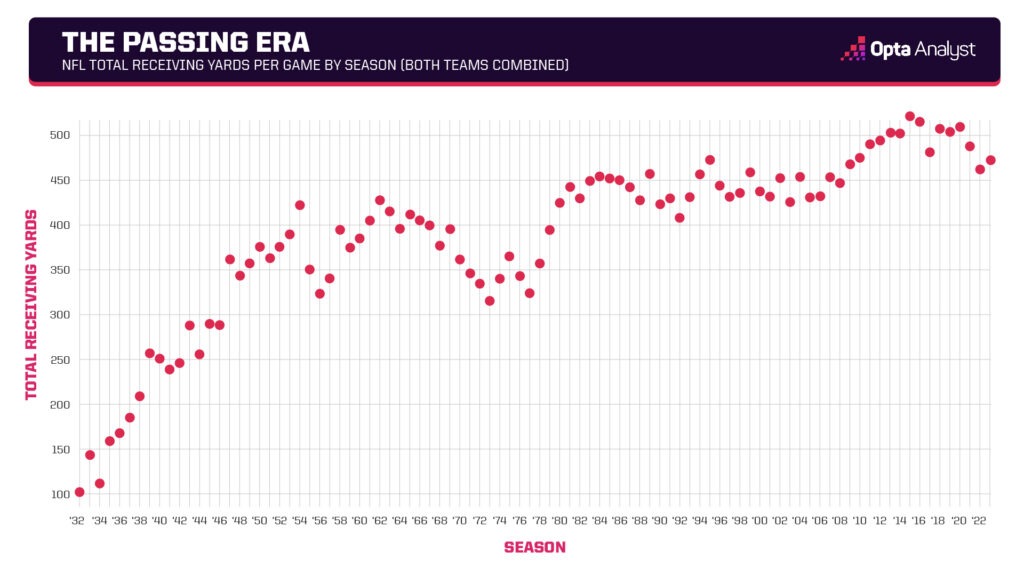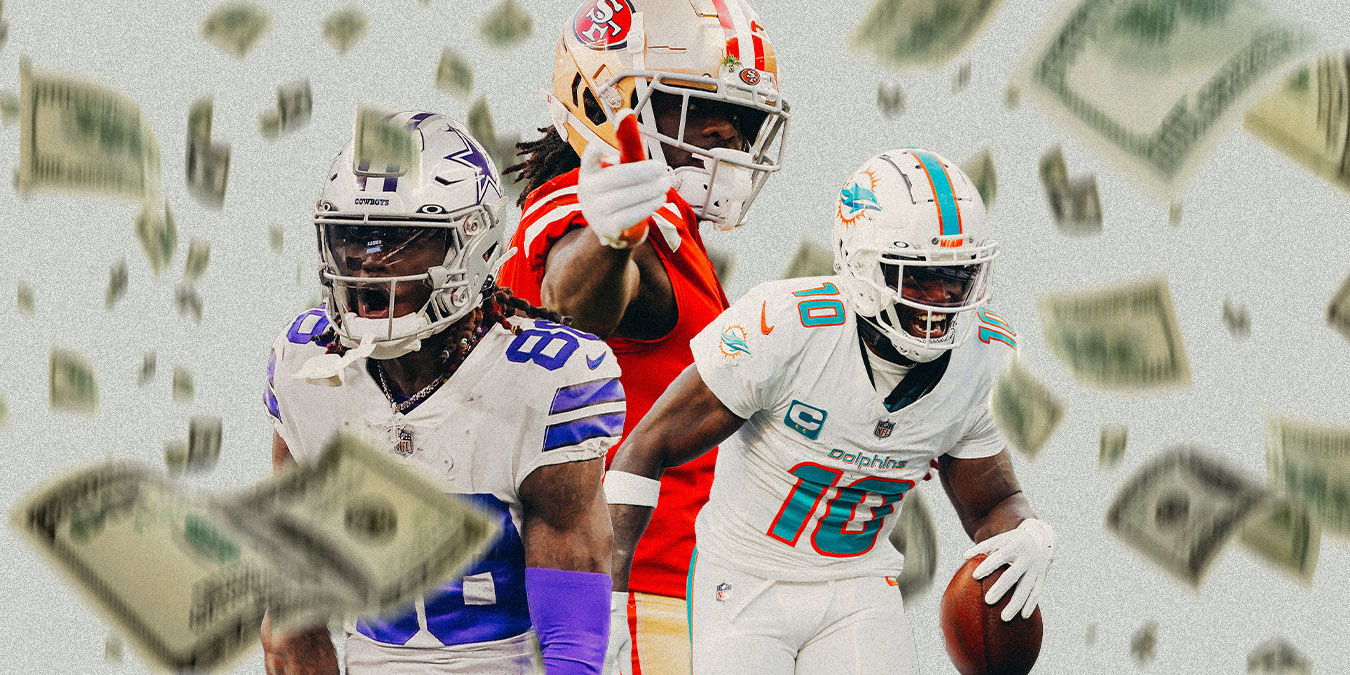Two years after there was a major bump in receiver price tags, the market experienced another boom this offseason. Giving more than 10% of the cap to one WR is a steep price to pay. So are the highest-paid wide receivers worth it in 2024?
The wide receiver market experienced a huge boom in 2024 when 15 wideouts signed deals worth at least $20 million a year.
This included not one, not two, but three record-breaking contracts in a matter of months that reset and reshaped how much teams will need to pay the position moving forward.
Where only one receiver made an average of $30 million per year in 2022, there are now six in 2024 after Justin Jefferson of the Minnesota Vikings, CeeDee Lamb of the Dallas Cowboys, A.J. Brown of the Philadelphia Eagles, Amon-Ra St. Brown of the Detroit Lions, Brandon Aiyuk of the San Francisco 49ers and Tyreek Hill of the Miami Dolphins all reached that threshold with their new contracts.
Jefferson leads the highest-paid receiver rankings at $35 million (average annual value) after signing a four-year, $140-million contract extension, while Lamb isn’t far behind at $34 million a year. There is also a high likelihood Ja’Marr Chase of the Cincinnati Bengals either joins this group or leads it as soon as he signs his next contract.
This unprecedented movement comes just two years after our Trevor Goldstein broke down another major bump in receiver price tags. That year, seven players signed deals worth an average of $20 million or more annually (including Hill, the first $30-million wideout in NFL history) after just four receivers had eclipsed that mark before the 2022 offseason.
There are now 23 total receivers who make at least $20 million per year, including 11 who make more than $25 million a year. Two years ago, those numbers were just 14 and five.
That’s the going rate for a No. 1 receiver in the new NFL. Productive pass catchers are a staple of any good offense in the league now, as evidenced by 27 receivers hitting at least 1,000 receiving yards this past year — a six-player bump from the previous year and a 10-year high at the position.
This past season was also the third consecutive year with three receivers who broke 1,500 yards through the air. The only other times that happened over the past decade were in 2015 and 2018.

Receivers know their worth, too. Lamb and Aiyuk held out for considerable lengths of time this offseason before eventually signing huge contracts less than two weeks before the season. The 49ers grappled with paying or trading Aiyuk, while the Cowboys appeared noncommittal on keeping Lamb before eventually succumbing to his contract request. Chase remains a major question mark as well with the 2024 season set to kickoff Thursday night.
The majority of the players who signed this offseason were coming off their rookie contracts. Jefferson, Lamb, Aiyuk and Michael Pittman Jr. of the Indianapolis Colts were all part of the 2020 NFL Draft, while Jaylen Waddle of the Dolphins, DeVonta Smith of the Eagles, Nico Collins of the Houston Texans and St. Brown were drafted in 2021.
That makes sense given this group vastly outplayed their contracts and were due for extensions or the franchise tag soon. It happens every year and will be a big part of the next wave of receiver deals as soon as 2025.
But what’s interesting is that the market for quality aging veterans didn’t wane in 2024. Hill (who recently turned 30) re-negotiated his contract to remain among the top-five highest-paid WRs, Brown re-negotiated to bump his APY past the $30 million mark and even Calvin Ridley (who’ll be 30 in December) and Mike Evans (who just turned 31) earned a lot of guaranteed money.
This makes the 2025 offseason a very interesting one for the receiver market. Not only are there at least five young receivers who should earn new deals (this includes Chase), there are also older, quality veterans who are in line for another extension.
Top Options in the 2025 WR Market
- Ja’Marr Chase, Cincinnati Bengals
- Tee Higgins, Cincinnati Bengals
- Garrett Wilson, New York Jets
- Chris Olave, New Orleans Saints
- Drake London, Atlanta Falcons
- DeAndre Hopkins, Tennessee Titans
- Stefon Diggs, Houston Texans
- Keenan Allen, Chicago Bears
- Chris Godwin, Tampa Bay Buccaneers
- Mike Williams, New York Jets
The crucial question is, though: Are these deals worth it for teams? Giving more than 10% of the salary cap to one receiver who, at most, will touch the ball 10-15 times a game is a steep price to pay when there are other positions to consider.
It’s a big reason why the Cowboys and 49ers waffled on extending Lamb and Aiyuk, respectfully, and why the Bengals have been bullish to pay Tee Higgins and Chase.
Bluntly speaking, spending on receivers rarely equates to playoff success. Only 11 of the 42 teams who made the postseason since 2021 finished top 10 in both money and salary cap percentage allocated to the receiver position. Those teams won a total of four playoff games during those three years (coincidentally, the Tampa Bay Buccaneers accounted for three of those wins) and none made it past the divisional round.
It looks even bleaker for this expenditure in 2024. Only three of the top-10 teams in receiver spending this year have above a 60% chance of making the playoffs (the 49ers, Lions and Seattle Seahawks), according to our model. And if you just look at the top 10 individually paid receivers, only the Cowboys get added to the aforementioned list with Lamb.
Meanwhile, four of the bottom-10 teams in overall receiver spending — the Green Bay Packers, Baltimore Ravens, Atlanta Falcons and Lions — are projected to make the playoffs.
Top-10 WRs by Salary Cap% (Cap%/Team Playoff%)
- Justin Jefferson, Minnesota Vikings (13.7%/6.6%)
- Davante Adams, Las Vegas Raiders (13.5%/26.3%)
- CeeDee Lamb, Dallas Cowboys (13.3%/68.1%)
- Cooper Kupp, Los Angeles Rams (12.8%/50.3%)
- A.J. Brown, Philadelphia Eagles (12.5%/31.9%)
- Amon-Ra St. Brown, Detroit Lions (11.8%/60.9%)
- Brandon Aiyuk, San Francisco 49ers (11.8%/95.2%)
- Tyreek Hill, Miami Dolphins (11.8%/75.7%)
- D.K. Metcalf, Seattle Seahawks (11.5%/61.4%)
- Deebo Samuel, San Francisco 49ers (11.5%/95.2%)
So if history and statistics show that paying for a receiver is a bad investment, why do teams consistently continue to do it? Because even though it doesn’t always equate to winning games, the best teams still have the best receivers. Nine of the top-10 receivers in the NFL played on playoff teams last season, seven in 2022 and eight in 2021.
The key is timing. Teams need to strike while the iron is hot and their best players are still on rookie deals, otherwise, the window will close and other positions will become too expensive to splurge on.
The Chiefs are perhaps the best example of this methodology, as they traded Hill to the Dolphins in 2022 when he wanted a new contract rather than break the bank on their No. 1 receiver. However, Kansas City is unique in that it still had Patrick Mahomes and Travis Kelce teaming for touchdowns, as well as the best offensive coach in Andy Reid on the sideline. Those three elements negated Hill’s presence (in the form of back-to-back Super Bowl titles), and therefore the urgency to pay him.
Sadly, this is not the norm for teams who have to decide on their receiver. The rest of the teams who signed long-term extensions either had the cap space to do it thanks to a quarterback on a rookie or below-market deal, or they had just paid their quarterback with no receiver depth behind their first pass catcher.
None of these teams have a Mahomes-caliber passer, either.
There is no tried-and-true strategy to retain receiver talent and keep a team in playoff contention, but 2024 might be the year we see something change. Ten of the 15 receivers who signed deals with more than $20 million a year this offseason played on teams who made the postseason a year ago.
Seven of those 10 play on teams with more than a 60% chance to make the playoffs this year, with the Eagles (Brown, who the Tennessee Titans opted to trade instead of pay, and Smith) and the Buccaneers (Evans) being the only two teams with a lower probability.
So depending on how this season goes, the avalanche of megadeals signed this offseason may signal a trend-setting change when it comes to paying pass catchers. It certainly wasn’t the best long-term decision in the past, but the market could necessitate a course correction of general managers in the future.
Things could come to a head in 2025 when a new crop of receivers will be up for new deals.
Be sure to check out our MLB, NBA, NFL and CFB coverage. And follow us on X and Instagram for more!
